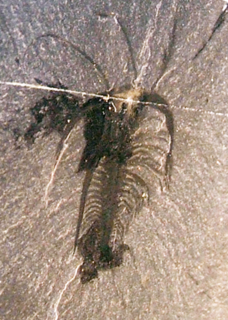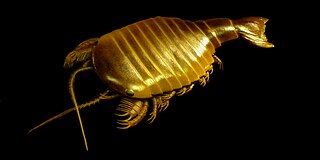
The Burgess Shale is a fossil-bearing deposit exposed in the Canadian Rockies of British Columbia, Canada. It is famous for the exceptional preservation of the soft parts of its fossils. At 508 million years old, it is one of the earliest fossil beds containing soft-part imprints.

Marrella is an extinct genus of marrellomorph arthropod known from the middle Cambrian Burgess Shale of British Columbia. It is the most common animal represented in the Burgess Shale, with tens of thousands of specimens collected. Much rarer remains are also known from deposits in China.

Wiwaxia is a genus of soft-bodied animals that were covered in carbonaceous scales and spines that protected it from predators. Wiwaxia fossils – mainly isolated scales, but sometimes complete, articulated fossils – are known from early Cambrian and middle Cambrian fossil deposits across the globe. The living animal would have measured up to 5 cm (2 inch) when fully grown, although a range of juvenile specimens are known, the smallest being 2 millimetres (0.079 in) long.

Sidneyia is an extinct arthropod known from fossils found from the Early Cambrian-age Maotianshan Shales to the Mid Cambrian Burgess Shale formation of British Columbia. 144 specimens of Sidneyia are known from the Greater Phyllopod bed, where they comprise 0.27% of the community.

Ottoia is a stem-group archaeopriapulid worm known from Cambrian fossils. Although priapulid-like worms from various Cambrian deposits are often referred to Ottoia on spurious grounds, the only clear Ottoia macrofossils come from the Burgess Shale of British Columbia, which was deposited 508 million years ago. Microfossils extend the record of Ottoia throughout the Western Canada Sedimentary Basin, from the mid- to late- Cambrian. A few fossil finds are also known from China.

The Emu Bay Shale is a geological formation in Emu Bay, South Australia, containing a major Konservat-Lagerstätte. It is one of two in the world containing Redlichiidan trilobites. The Emu Bay Shale is dated as Cambrian Series 2, Stage 4, correlated with the upper Botomian Stage of the Lower Cambrian.
The Kaili Formation is a stratigraphic formation which was deposited during the Lower and Middle Cambrian. The formation is approximately 200 metres (660 ft) thick and was named after the city Kaili in the Guizhou province of southwest China.

Dinomischusis a rare fossil animal from the Cambrian period. It reached 20 mm in height, was attached to the sea floor by a stalk, and looked loosely like a flower. The cup-shaped body at the top of the stalk probably fed by filtering the surrounding seawater, and may have created a current to facilitate this. Its mouth and anus sat next to one another.

Leanchoilia is an megacheiran arthropod known from Cambrian deposits of the Burgess Shale in Canada and the Chengjiang biota of China. It was about 5 centimetres (2.0 in) long and had long, whip-like feelers mounted on frontal arm-like appendages. Its internal organs are occasionally preserved within the substrate in three dimensions.

Urokodia aequalis is an extinct genus of arthropod from the early Cambrian. The taxon is only known from the Maotianshan Shales of China based on some 15 specimens. Its segmentation resembles that of a millipede and it possessed head and tail shields with thorny spikes. It has some similarities to the arthropod Mollisonia that is known from both the Burgess Shale of Canada and the Kaili biota of China. Recently, the taxon has been considered a member of the order Mollisoniida, alongside Mollisonia, Thelxiope, and Corcorania, the group are suggested to be stem-chelicerates.
The Burgess Shale of British Columbia is famous for its exceptional preservation of mid-Cambrian organisms. Around 69 other sites have been discovered of a similar age, with soft tissues preserved in a similar, though not identical, fashion. Additional sites with a similar form of preservation are known from the Ediacaran and Ordovician periods.
A number of assemblages bear fossil assemblages similar in character to that of the Burgess Shale. While many are also preserved in a similar fashion to the Burgess Shale, the term "Burgess Shale-type fauna" covers assemblages based on taxonomic criteria only.

Tuzoia is an extinct genus of large bivalved arthropod known from Early to Middle Cambrian marine environments in what is now the Burgess Shale, Emu Bay Shale (Australia), Kaili, the Rockslide Formation, the Spence Shale, Wheeler Formation, and Marjum Formation (Utah), and the Kinzers Formation (Pennsylvania). This arthropod reached lengths of 180 mm. There are currently 7 valid species recognized.

Marrellomorpha are an extinct group of arthropods known from the Cambrian to the Early Devonian. They lacked mineralised hard parts, so are only known from areas of exceptional preservation, limiting their fossil distribution. The best known member is Marrella, with thousands of specimens found in the Cambrian aged Burgess Shale of Canada. The group is divided up into two major orders, Marrellida and Acercostraca. Marrellida is recognised by the possession of head shields with two or three pairs of elongate spine-like projections, and three pairs of uniramous appendages on the cephalon, while Acercostraca generally have large ovoid carapaces that cover the entire upper half of the body, and five pairs of uniramous cephalic appendages. Both groups have unbranched antennules and a segmented trunk with biramous appendages. Recent research has suggested the previously enigmatic Cambrian trliobite-like arthropods Skania and Primicaris may belong to this group. Their phylogenetic position is uncertain, various studies have alternatively placed them within in the Arachnomorpha as relatives of Artiopoda, as stem-group Mandibulata, or as stem group euarthropods.
The Phyllopod bed, designated by USNM locality number 35k, is the most famous fossil-bearing member of the Burgess Shale fossil Lagerstätte. It was quarried by Charles Walcott from 1911–1917, and was the source of 95% of the fossils he collected during this time; tens of thousands of soft-bodied fossils representing over 150 genera have been recovered from the Phyllopod bed alone.
Bosworthia is a genus of branching photosynthetic alga known from the Middle Cambrian Burgess Shale.

Mollisonia is an extinct genus of Cambrian arthropod. Species are known from the Burgess Shale, Langston Formation, and Wheeler Shale of North America, as well as the Chengjiang Biota of China.

Pagetia Walcott, 1916. is a small genus of trilobite, assigned to the Eodiscinid family Pagetiidae and which had global distribution during the Middle Cambrian. The genus contains 55 currently recognized species, each with limited spatial and temporal ranges.

Sphenothallus is a problematic extinct genus lately attributed to the conulariids. It was widespread in shallow marine environments during the Paleozoic.
The Balang formation, is a Cambrian Period geological formation, which outcrops in Hunan Province, southern China.













